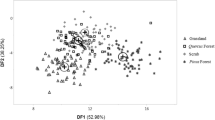Abstract
Phytosociological classification of vegetation is often justified on the grounds it provides a means of predicting properties other than floristic composition. It is difficult to find examples inliterature where this possibility of prediction is actually used. In this paper, we examine the qualitative variation in proazulenes of theAchillea millefolium group as a function of cytological, abiotic and floristic factors. Sixty-six sites in natural populations were examined. Twenty to forty individuals per site were tested in the field for the presence of proazulenes. Ploidy level of collected specimens was examined to differentiate between taxa within the aggregate. Soil analyses were also performed and species composition of the sites was recorded. The floristic data was classified and attributed to phytosociological units.
Canonical correspondence analysis was used to investigate the relationships between environment and floristic data, t-tests were performed and correlation coefficients were calculated to distinguish the mutual relationships between environmental factors, populations and relative frequency of proazulenes-containing individuals. In the area under study, hexaploid populations of yarrows were characterized by a low frequency of proazulenes. They were confined to dry and nutrient-poor habitats of fallows, slightly moist grasslands and fringes. Tetraploid populations consisted of different types. Both high and low frequencies of proazulenes-containing individuals occurred. A high frequency of such plants per site was positively correlated with phosphate, magnesium and manganese and negatively with carbonate and hydrogen ion concentration in soil.
The results show that effective prediction of proazulenes-containing individuals is possible from the species composition of the sites, which is a comparatively simple procedure avoiding more expensive cytological and chemical assessment.
Similar content being viewed by others
References
Arbeitsgruppe Bodenkunde (1982):Bodenkundliche Kartieranleitung. Ed. 3. E. Schweizerbart’sche Verlagsbuchhandlung, Stuttgart, Hannover.
Bemmerlein F.A. &Fischer H.S. (1985): Das pflanzensoziologische Programmsystem am Regionalen Rechenzentrum Erlangen.Hoppea 44: 373–378.
Biste C. (1978): Zytotaxonomische Untersuchungen des FormenkreisesAchillea millefolium (Asteraceae) in der DDR.Feddes Repert. 88: 533–613.
Braun-Blanquet J. (1964):Pflanzensoziologie. Grundzüge der Vegetationskunde. Ed. 3. Springer, Wien.
Bugge G. (1991): Untersuchungen der Sippen desAchillea-millefolium-Komplexes auf Azulengehalt und Ploidiegrad.Angew. Bot. 65: 331–339
Dabrowska J. (1972): Obserwacje rozmieszenia azulenowych i bezazulenovych formAchillea L. na Śląsku na tłe danych o rozmiesczeniu taksonów rodzajuAchillea L. na tym obszarze.Herba Polon. 18: 40–69.
Dabrowska J. (1982): Systematic and geographic studies of the genusAchillea L. in Poland with special reference to Silesia.Acta Univ. Wratislav. 419. Prace Bot. 24: 1–222.
Dierschke H. (1997):Synopsis der Pflanzengesellschaften Deutschlands. 3: Molinio-Arrhenatheretea. Selbstverlag der Floristisch-soziologischen Arbeitsgemeninschaft e.V., Göttingen.
Ehrendorfer F. (1953): Systematische und cytogenetische Untersuchungen an europäischen Rassen desAchillea millefolium-Komplexes.Österr. Bot. Z. 100: 583–592.
Ehrendorfer F. (1957): Akzessorische Chromosomen, Kreuzungsfertilität und Polyploidie beimAchillea millefolium-Komplex (Compositae).Naturwissenschaften 44: 405–406.
Ehrendorfer F. (1962): Cytotaxonomische Beiträge zur Genese der mitteleuropäischen Flora und Vegetation.Ber. Deutsch. Bot. Ges. 75: 137–152.
Ehrendorfer F. (ed.) (1973):Liste der Gefässpflanzen Mitteleuropas. Ed. 2. Fischer Verlag, Stuttgart.
Fischer H.S. (1994) Simulation der räumlichen Verteilung von Pflanzengesellschaften auf der Basis von Standortskarten. Dargestellt am Beispiel des MaB-Testgebiets Davos.Veröff. Geobot. Inst. ETH Stiftung Rübel Zürich 122.
Hauser K. (1988): Pflanzengesellschaften der mehrschürigen Wiesen (Molinio-Arrhenatheretea) Nordbayerns.Diss. Bot. 128.
Hofmann L., Fritz D., Nits S., Kollmansberger H. &Drawert F. (1992): Essential oil composition of three polyploids in theAchillea millefolium “complex”.Phytochemistry 31: 537–542.
Jurenitsch J. (1992):Achillea. In:Hänsel R., Keller K., Rimpler H. &Schneider G.,Hagers Handbuch der Pharmazeutischen Praxis. 4: Drogen A-D, Springer Verlag, Berlin, Heidelberg, pp. 45–50.
Lange D. (1996):Untersuchungen zum Heilpflanzenhandel in Deutschland. Ein Beitrag zum internationalen Artenschutz. Bundesamt für Naturschutz, Bonn, Bad Godesberg,
Mather P.M. (1987):Computer processing of remotely-sensed images. Wiley, New York.
Michler B., Preitschopf A., Erhard P. &Arnold C.-G. (1992):Achillea millefolium: Zusammenhänge zwischen Standortfaktoren, Ploidiegrad, Vorkommen von Proazulenen und Gehalt an Chamazulen im äterischen Öl.Pharm. Zeitung Wiss. 137: 23–29.
Michler B. &Arnold C.-G. (1996): Pyrrolizidinalkaloide in Beinwellwurzeln. Ein Beispiel für die Variabilität sekundärer Pflanzeninhaltsstoffe.Deutsche Apotheker-Zeitung 136, 29: 15–20.
Muller C.H. (1969): Allelopathy as a factor in ecological process.Vegetatio 18: 348–357.
Muller C.H. (1970): Phytotoxins as plant habitat variables.Recent Advances Phytochem. 3: 106–121.
Oberdorfer E. (1978):Süddeutsche Pflanzengesellschaften II. Gustav Fischer Verlag, Stuttgart, New York.
Oberdorfer E. (1983):Süddeutsche Pflanzengesellschaften III. Gustav Fischer Verlag, Stuttagart, New York.
Oberdorfer E. (1994):Pflanzensoziologische Exkursionsflora. Ed. 6. Ulmer Verlag, Stuttgart.
Preitschopf A. (1989):Achillea millefolium: Vorkommen — Ploidiestufe — Proazulenführung. Diploma Thesis, Universität Erlangen, Erlangen.
Pudlatz H. (1975): Zur Transformation der Variablen bei mangelnder Normalverteilung.Giessener Geogr. Schriften 32: 29–33.
Saukel J. &Länger R. (1992a): DieAchillea millefolium-Gruppe (Asteraceae) in Mitteleuropa, 1 — Problemstellung, Merkmalserhebung und Untersuchungsmaterial.Phyton (Horn, Austria) 31: 185–207.
Saukel J. &Länger R. (1992b): DieAchillea millefolium-Gruppe (Asteraceae) in Mitteleuropa, 2 — Populationsvergleich, multivariate Analyse und biosystematische Anmerkungen.Phyton (Horn, Austria) 32: 47–78.
Saukel J. &Länger R. (1992c):Achillea pratensisSaukel & Länger, spec. nova, eine tetraploide Sippe derAchillea millefolium-Gruppe.Phyton (Horn, Austria) 32: 159–172.
Schlee D. (1992):Ökologische Biochemie. Ed. 2. Fischer Verlag, Jena.
Stahl E. (1952): Ist der Proazulengehalt der Schafgarbe (Achillea millefolium L.) genetisch oder umweltbedingt?Parmazie 7: 863–868.
Stahl E. (1953): Mikro-Azulennachweismethode für Schafgarben.Deutsche Apotheker-Zeitung 12: 197–200.
ter Braak C.J.F. (1988):CANOCO — a FORTRAN program for canonical community ordination by [partial] [detrended] [canonical] correspondence analysis, principal components analysis and redundancy analysis (version 2.1). Technical report: LWA8802. Agricultural Mathematics Group, Wageningen.
ter Braak C.J.F. (1990):Update notes: CANOCO Version 3.10. Agricultural Mathematics Group, Wageningen.
VDLUFA (1991):Methodenbuch 1, Die Untersuchung von Böden. VDLUFA-Verlag, Darmstadt.
Vetter S. (1995): Kreuzungsexperimente mit tetraploiden Sippen derAchillea millefolium-Gruppe (Asteraceae): Sesquiterpene und morphologische Merkmale hybridogener F1-Populationen im Vergleich.Liner Biol. Beitr. 27: 1161–1211.
Vetter S. &Franz Ch. (1998): Samenbildung bei Kreuzungen und Selbstungen mit polyploidenAchillea-Arten (Asteraceae).Z. Arznei- Gewürzpflanzen 3: 11–14.
Westhoff V. &van der Maarel E. (1973): The Braun-Blanquet approach. In:Whittaker R.H. (ed.),Classification of Plant communities, Junk Verlag, The Hague, pp. 287–399
Wildi O. &Orlóci L. (1990):Numerical exploration of community patterns. SPB Academic Publishing, The Hague.
Wildi O. (1989): A new numerical solution to traditional phytosociological tabular classification.Vegetatio 81: 95–106.
Author information
Authors and Affiliations
Corresponding author
Rights and permissions
About this article
Cite this article
Michler, B., Arnold, CG. Predicting presence of proazulenes in theAchillea millefolium group. Folia Geobot 34, 143–161 (1999). https://doi.org/10.1007/BF02803081
Issue Date:
DOI: https://doi.org/10.1007/BF02803081




